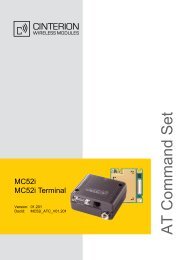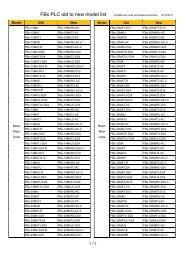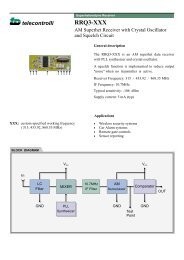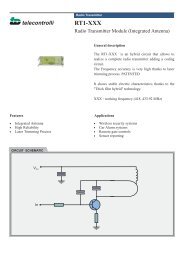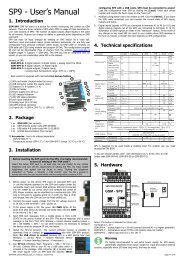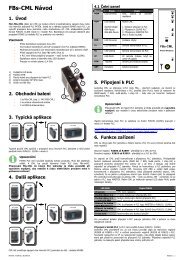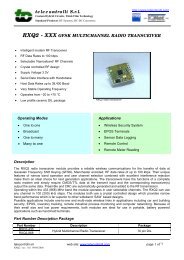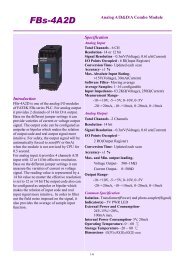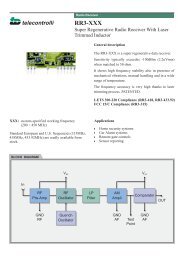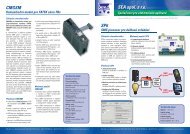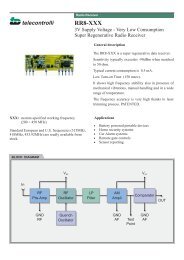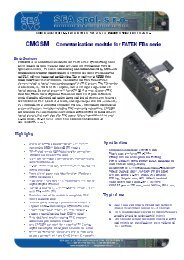Chapter 21 Temperature Measurement of FBs-PLC and PID Control
Chapter 21 Temperature Measurement of FBs-PLC and PID Control
Chapter 21 Temperature Measurement of FBs-PLC and PID Control
Create successful ePaper yourself
Turn your PDF publications into a flip-book with our unique Google optimized e-Paper software.
FUN86<br />
TPCTL<br />
Convenient Instruction <strong>of</strong> <strong>PID</strong> <strong>Temperature</strong> <strong>Control</strong><br />
FUN86<br />
TPCTL<br />
Note 1 : When changing the value <strong>of</strong> R4005, the execution control “EN” <strong>of</strong> FUN86 must be set at 0. The next time<br />
when execution control “EN” =1, it will base on the latest set point to perform the <strong>PID</strong> calculation.<br />
Note 2 : The smaller the cycle time <strong>of</strong> PWM, the more even can it perform the heating. However, the error<br />
caused by the <strong>PLC</strong> scan time will also become greater. For the best control, it can base on the scan time<br />
<strong>of</strong> <strong>PLC</strong> to adjust the solution interval <strong>of</strong> <strong>PID</strong> calculation <strong>and</strong> the PWM cycle time.<br />
● R4006:The setting point <strong>of</strong> large power output detection for SSR or heating circuit opened, or heating b<strong>and</strong><br />
obsolete. The unit is in % <strong>and</strong> the setting range falls in 80~100(%); system default is 90(%).<br />
● R4007:The setting time to detect the continuing duration <strong>of</strong> large power output while SSR or heating circuit<br />
opened, or heating b<strong>and</strong> obsolete. The unit is in second <strong>and</strong> the setting range falls in 60~65535<br />
(seconds); system default is 600 (seconds).<br />
● R4008:The setting point <strong>of</strong> highest temperature warning for SSR, or heating circuit short detection. The unit<br />
is in 0.1 degree <strong>and</strong> the setting range falls in 100~65535; system default is 3500 (Unit in 0.1°).<br />
● R4012:Each bit <strong>of</strong> R4012 to tell the need <strong>of</strong> <strong>PID</strong> temperature control.<br />
Bit0=1 means that 1 st point needs <strong>PID</strong> temperature control.<br />
Bit1=1 means that 2 nd point needs <strong>PID</strong> temperature control.<br />
‧<br />
‧<br />
Bit15=1 means that 16 th point needs <strong>PID</strong> temperature control.<br />
(The default <strong>of</strong> R4012 is FFFFH)<br />
● R4013:Each bit <strong>of</strong> R4013 to tell the need <strong>of</strong> <strong>PID</strong> temperature control.<br />
Bit0=1 means that 17 th point needs <strong>PID</strong> temperature control.<br />
Bit1=1 means that 18 th point needs <strong>PID</strong> temperature control.<br />
‧<br />
‧<br />
Bit15=1 means that 32 th point needs <strong>PID</strong> temperature control.<br />
(The default <strong>of</strong> R4013 is FFFFH)<br />
●<br />
●<br />
●<br />
While execution control “EN”=1 <strong>and</strong> the corresponding bit <strong>of</strong> <strong>PID</strong> control <strong>of</strong> that point is ON (corresponding<br />
bit <strong>of</strong> R4012 or R4013 must be 1), the FUN86 instruction will perform the <strong>PID</strong> operation <strong>and</strong> respond to the<br />
calculation with the output signal.<br />
While execution control “EN”=1 <strong>and</strong> the corresponding bit <strong>of</strong> <strong>PID</strong> control <strong>of</strong> that point is OFF<br />
(corresponding bit <strong>of</strong> R4012 or R4013 must be 0), the FUN86 will not perform the <strong>PID</strong> operation <strong>and</strong> the<br />
output <strong>of</strong> that point will be OFF.<br />
The ladder program may control the corresponding bit <strong>of</strong> R4012 <strong>and</strong> R4013 to tell the FUN86 to perform or<br />
not to perform the <strong>PID</strong> control, <strong>and</strong> it needs only one FUN86 instruction.<br />
<strong>21</strong>-15



